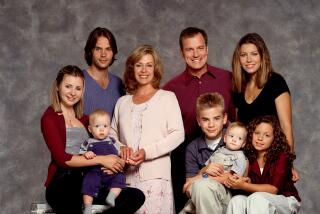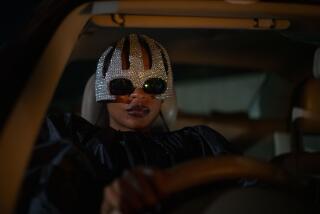Perspective: A little splice of heaven
If there’s an afterlife, here’s hoping it turns out to be like the tasty one that writer-director Albert Brooks envisioned in “Defending Your Life.” In the 1991 comedy, Meryl Streep’s character blissfully slurps up mounds of spaghetti because, in eternity, all food is fabulously delicious and the eater never gains an ounce.
Filmmakers have been putting versions of heaven and its iterations on screen going back to the days of silents. The latest to try is writer-director Terrence Malick, who in his arty and evocative “The Tree of Life” suggests that the dead live on — and we’re not talking a zombie movie.
Malick has made a purposefully religious film, one that, right from the start, has a character announce that its theme is grace versus nature. Characters quote from the Bible, and “Life’s” elliptical story revolves around a father (played by Brad Pitt) and son.
For much of “Life,” we watch as a solitary figure (Sean Penn), the adult version of the youth at the film’s center, trudges across great distances, passing through various stark landscapes. Then, near the end, he arrives at a brightly lit beach filled with people who saunter past, flashing beckoning smiles. As the sun glints off the sand and water and brilliant white clouds swell overhead, Penn’s character sees a brother who died years ago — he’s still a tow-headed stripling — and other members of his family.
What should be one of the film’s most resonant moments, coming as it does after “Life’s” deeply felt and impressionistic portrait of childhood and family life in a small Midwestern town, instead embraces every cheesy cinematic cliché.
Yep, this must be heaven. Not only is it heaven, but it’s a heaven we’ve seen in way too many other films, one of sunshine and gauzy outfits and gentle smiles. C’mon, Mr. Malick, this is the best you can do? The caption from a famous New Yorker cartoon springs to mind: “I say it’s spinach, and I say the hell with it!”
Malick and other moviemakers who’ve taken a shot at staging heaven are looking to answer the big question: What, if anything, comes after?
In the first few decades of moviemaking, the answer typically was a heaven bursting with fluffy clouds and angels strumming on harps. Probably the most surrealistic of these versions, and certainly the most racist, came in “Wonder Bar,” a 1934 musical. “The Jazz Singer’s” Al Jolson, again in blackface, finds himself in a heaven where pork chops dangle from trees and chorus girls, also in blackface, prance about holding giant slices of watermelon.
In 1941’s “Here Comes Mr. Jordan,” when Robert Montgomery’s prizefighter is prematurely plucked from a plane crash, he walks atop and among feathery white clouds as he makes his way to meet the afterlife’s presiding gatekeeper, a benevolent, silver-haired Claude Rains, who is checking off names on a list of passengers bound for the hereafter. (Warren Beatty remade “Mr. Jordan” in 1978 as “Heaven Can Wait” and co-directors Chris Weitz and Paul Weitz recycled it as a Chris Rock vehicle in 2001’s “Down to Earth.”)
In recent years, a much wider range of possible heavens have turned up on screen. Presumably, these tell us more about the filmmaker’s vision than they reveal about what actually lies ahead. (No one has come back from the dead with a documentary, though the current No. 1 nonfiction bestselling book is “Heaven is for Real,” in which a 4-year old boy recounts his supposed visit to the Great Beyond.)
For sheer glamour and star power, it’s hard to beat Steven Spielberg’s take on the hereafter. In 1989’s “Always,” he cast Audrey Hepburn — it was to be her final film — as the afterlife representative who guides a downed pilot (Richard Dreyfuss) toward accepting his fate. She didn’t sport wings or a halo, but Hepburn’s chic all-white outfit (a cable-knit sweater and pants) suggested that heaven might be something akin to “The Final Breakfast at Tiffany’s.” All that was missing was the pearls.
With the rise of digital special effects in recent decades, visions of heaven have leaned toward cheesy, trippy phantasmagorias. In 1998’s “What Dreams May Come,” directed by Vincent Ward, a newly dead Robin Williams walked toward the blinding white light at the end of a tunnel to find himself in a paradise filled with lush, gaudily colored flora and fauna.
Equally prettified was “Lord of the Rings” director Peter Jackson’s take in 2009’s “The Lovely Bones.” While waiting for her murderer to be caught, “Bones’” adolescent protagonist was stuck in a spot just below heaven, which Jackson depicted as an ever-changing, pulsating landscape full of intense, Candy Land hues. If it turns out there’s AstroTurf in heaven, Jackson put it there.
Then there are those filmmakers who envision a more prosaic, minimalist heaven, and are often all the more effective for their restraint. Two of the best: The sublime final scene in director-writer Robert Benton’s “Places in the Heart” (1984) shows the living and the dead, the good and the bad, all taking communion together in the dusty haze of a Great Depression-wracked Texas in the 1930s.
More recently, in 1998’s “After Life,” a wonderfully spare and yet moving Japanese film by director-writer Hirokazu Koreeda, the newly departed find themselves in an ordinary bureaucratic office. They are asked by kindly attendants to recall a single moment from their life when they were happiest. That moment is then re-created by a film crew and is the only memory the person will take with them to eternity.
When it comes to showing heaven in movies, less is more. Concentrating on emotions and memories rather than clouds and clichés is always a better way to go.
And what of hell? Lots of movies have gone there too, but again “Defending Your Life” nails it. When Brooks’ newly dead character nervously asks whether there’s a hell, one of eternity’s gatekeepers reassures him, “Actually, there’s no hell, though I hear that Los Angeles is getting pretty close.”
More to Read
The biggest entertainment stories
Get our big stories about Hollywood, film, television, music, arts, culture and more right in your inbox as soon as they publish.
You may occasionally receive promotional content from the Los Angeles Times.










